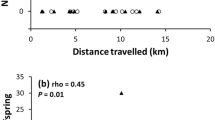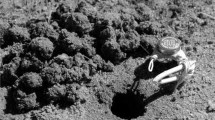Abstract
In the stream-dwelling isopod Lirceus fontinalis, males and females engage in a precopulatory mate guarding phase prior to mating. We examined the energetic costs of mate guarding behavior in males by separately assaying glycogen and lipid content at different time increments following mating. We found that males that had recently mated possessed reduced glycogen reserves and that these reserves were fully replenished within 36 h. Conversely, we found that male lipid reserves were unaffected by time since mating. We concluded that precopulatory mate guarding behavior is energetically costly to males and that glycogen is the energy source utilized to pay that cost. We also examined whether food deprivation during the mate guarding phase affected male energy reserves (glycogen) at the end of that phase. We found that males that were held in the laboratory and starved during mate guarding possessed reduced glycogen at the termination of the phase when compared to fed males. This reduced quantity was equivalent to the glycogen reserves of recently mated males collected from the field. We propose that food deprivation during the mate guarding phase explains the reduction in glycogen reserves at the termination of that phase. We discuss these results with reference to patterns of refuge use behavior during the mate guarding phase.
Similar content being viewed by others
References
Adams J, Greenwood P, Pollit R, Yonow T (1985) Loading constraints and sexual size dimorphism in Asellus aquaticus. Behaviour 92: 277–287
Beenakkers AMT (1969) Carbohydrate and fat as a fuel for insect flight. A comparative study. J Insect Physiol 15: 353–361
Clarke A (1984) Lipid composition of two species of Serolis (Crustacea, Isopoda) from Antarctica. Br Antarct Surv Bull 64: 37–53
Downer RGH, Matthews JR (1976) Patterns of lipid distribution and utilization in insects. Am Zool 16: 733–745
Elwood RW, Dick JTA (1990) The amorous Gammarus: the relationship between precopula duration and size-assortative mating in G. pulex. Anim Behav 39: 828–833
Fairbairn DJ (1993) The costs of loading associated with matecarrying in the water strider Aquarius remigis. Behav Ecol 4: 224–231
George RY (1972) Biphasic moulting in Isopod Crustacea and the finding of an unusual mode of moulting in the Antarctic genus Glyptonotus. J Nat Hist 6: 651–656
Gilbert LI, Schneiderman HA (1961) Some biochemical aspects of insect metamorphosis. Am Zool 1: 11–51
Grafen A, Ridley M (1983) A model of mate guarding. J Theor Biol 102: 549–567
Heer LM (1974) Comparative life history of Lirceus fontinalis Refinesque (Isopoda, Asellota) in two limestone creeks near Lexington, Kentucky. MS thesis, University of Kentucky, Lexington
Holomuzki JR, Short TM (1988) Habitat use and fish avoidance behaviors by the stream- dwelling isopod Lirceus fontinalis. Oikos 52: 79–86
Hubricht L, Mackin JG (1949) The freshwater isopods of the genus Lirceus (Asellota, Asellidae). Am Midl Nat 42: 334–349
Kammer AE, Heinrick B (1978) Insect flight metabolism. Adv Insect Physiol 13: 133–228
Lee RF, Polhemus JT, Cheng L (1975) Lipids of the water-strider Gerris remigis Say (Heteroptera: Gerridae). Seasonal and developmental variations. Comp Biochem Physiol 51B: 451–456
Manning JT (1975) Male discrimination and investment in Asellus aquaticus (L.) and A. meridianus Racovitsza (Crustacea: Isopoda) Behaviour 55: 1–14
Parker GA (1974) Courtship persistence and female-guarding as male time investment strategies. Behaviour 48: 157–184
Pennak RW (1989) Fresh-water invertebrates of the United States, 3rd edn. Wiley, New York
Ridley M (1983) The explanation of organic diversity. Oxford University Press, Oxford
Ridley M, Thompson DJ (1979) Size and mating in Asellus aquaticus (Crustacea: Isopoda). Z Tierpsychol 51: 380–397
Rowe L (1994) The costs of mating and mate choice in water striders. Anim Behav 48: 1049–1056
SAS (1988) SAS/STAT User's Guide Release 6.03 edn. Cary, NC
Sparkes TC (1996) Effects of predation risk on population variation in adult size in a stream-dwelling isopod. Oecologia (in press)
Styron CE (1969) Taxonomy of two populations of an aquatic isopod, Lirceus fontinalis Raf. Am Midl Nat 82: 402–416
Styron CE, Burbanck WD (1967) Ecology of an aquatic isopod, Lirceus fontinalis Raf., emphasizing radiation effects. Am Midl Nat 78: 389–415
Suzuki SK, Yamasaki K, Katakura Y (1989) Vitellogenin synthesis by fat body and ovary in the terrestrial isopod, Armadillidium vulgare. Gen Comp Endocrinol 74: 120–126
Thompson DJ, Manning JT (1981) Mate selection by Asellus (Crustacea: Isopoda). Behaviour 78: 178–187
Unwin EE (1920) Notes upon the reproduction of Asellus aquaticus. J Linn Soc Lond Zool 34: 335–342
Van Handel E (1965) Microseparation of glycogen, sugars and lipids. Anal Biochem 11: 266–271
Van Handel E (1974) Lipid utilization during sustained flight of moths. J Insect Physiol 20: 2329–2332
Van Handel E (1985a) Rapid determination of glycogen and sugars in mosquitoes. J Am Mosq Control Assoc 1: 299–301
Van Handel E (1985b) Rapid determination of total lipids in mosquitoes. J Am Mosq Control Assoc 1: 302–304
Verrel PA (1985) Predation and the evolution of precopula in the isopod Asellus aquaticus. Behaviour 95: 198–202
Verspoor E (1982) Assortative mating for size in Asellus aquaticus (L.) (Isopoda). Crustaceana 43: 216–219
Wägele JW (1992) Isopoda. In: Harrison FW, Humes AG (eds) Microscopic anatomy of invertebrates, vol 9. Crustacea. Wiley-Liss, New York, pp 529–617
Ward PI (1986) A comparative field study of the breeding behaviour of a stream and pond population of Gammarus pulex (Amphipoda). Oikos 46: 29–36
Yamamura N (1987) A model of correlation between precopulatory guarding and short receptivity to copulation. J Theor Biol 127: 171–180
Author information
Authors and Affiliations
Corresponding author
Rights and permissions
About this article
Cite this article
Sparkes, T.C., Keogh, D.P. & Pary, R.A. Energetic costs of mate guarding behavior in male stream-dwelling isopods. Oecologia 106, 166–171 (1996). https://doi.org/10.1007/BF00328595
Received:
Accepted:
Issue Date:
DOI: https://doi.org/10.1007/BF00328595




